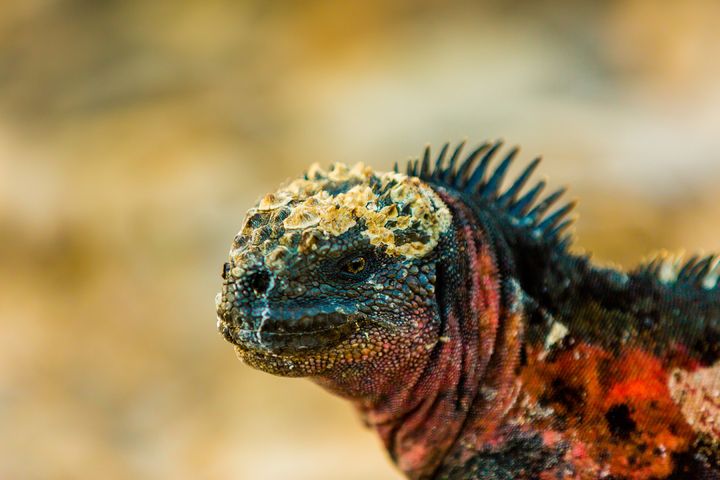
Did you know that Charles Darwin only spent 5 weeks in the Galapagos between September 15-October 20th, 1835? It only took a short time for him to realize what a unique gem he had found and to convince the rest of the world of the existence of these magical creatures that can only be found here on Earth. Darwin had originally come to see the volcanoes and to study the formation of our planet, but it would be the unique Galapagos wildlife that would make a lasting impression and lead to his research on the Theory of Natural Selection.

There are 13 major islands and 7 smaller islands that make up the Galapagos Archipelago about 620 miles off the coast of Ecuador and each of the islands are vastly different and have species endemic to just that island. The reason for this is that there are three currents in the ocean that meet here in this group of islands in the Pacific; the cold South Equatorial Current known as the Humboldt Current, The warm Panama Current runs in from north and finally the deep sea Cromwell Current runs from the west and is a source of upwelling when it hits the islands to bring nutrients from the bottom up to the surface layer. These nutrient rich currents all combine to create a ton of food for wildlife and also has brought animals in thousands of years ago on pieces of driftwood. Over the years these animals have learned to adapt to life on volcanoes and in the ocean, since that is what the islands are constantly being formed from, volcanic activity.


Unlike Darwin, it only took me only 8 days in the Galapagos to really get a sense of the sheer magic and beauty that this place holds. I have seen plenty of documentaries about the islands over the years, but even with my knowledge about the islands and how they were formed and its wildlife, nothing could have prepared me for some of the landscapes I was about to see. As I was flying in, literally there were giant volcanoes, miles of barren, black, ancient lava flows sinking into the ocean, half submerged volcanic craters that looked like half moons of land, green and turquoise waters, white sand beaches, and nothing else. No buildings, no roads, and no power lines almost everywhere that I looked. Other than the main tourist hub of Puerto Ayora on Santa Cruz Island, most places have been untouched by humans and are crawling with wildlife.



The reason that the Galapagos have largely remained unchanged is due to the great efforts of the Ecuadorian Government to highly protect this archipelago. Unless you are a scientist or marine biologist, tourism is very limited and you will only realistically be able to stay on or see about 2% of the islands. Visits to most of the islands aren’t allowed without a guide licensed with the Galapagos National Park. You can book day trips to some of the islands from Puerto Ayora in Santa Cruz, but taking a cruise on a small yacht is the best way to see the more remote islands and wildlife in the Galapagos. The national park restricts the size of boats to 100 passengers, but even 100 can overload a beach when disembarking all at once. Ideal tour boats take only small groups, such as 16 to 32 passengers. Rainforest Cruises is a sustainable travel company that books small cruises, as well as land-based hiking trips, eco-hotels, and dive excursion add-ons.



We chose to sail on the very latest luxury catamaran to from their fleet of boats, the Petrel. This beautiful boat manned by a crew of 11 ensures you the best creature comforts while you go in search of incredible wildlife on cruises of 4 days or longer. There are just Suites and Staterooms to accommodate a total of just 16 passengers so no matter where your boat lands, you are always in a small group of 16 or less to enjoy the tranquility of the natural environment around you. The Galapagos islands are considered to be a national park and everyone who visits has to pay $100 fee to enter, but part of that fee goes to the first class naturalist guide that accompanies you on your catamaran and on all of your hikes and excursions off the boat. So you will leave knowing so much more about the history of the islands and wildlife than you can ever imagine.

It is important to see at least 4 islands if you are planning a visit to the Galapagos, because each island is so vastly different than the next. So much so that while you are on a hike, the landscape even on just one island can change drastically within minutes. Because of this, we decided to do 4 days on a catamaran visiting the islands of San Cristobal, Española, Floreana and then finally docking on Santa Cruz island at Puerto Ayora. After our cruise we took a 2 hour water taxi to nearby Isabella Island to really experience a volcanic adventure on land. We wanted a well-rounded adventure in the Galapagos, so experiencing both the islands in the East that are older and have more vegetation and beaches versus the islands in the West that are still so raw and volcanic is a must do! Before I break down what each island is like, here is a list of what to do while exploring these pristine islands:
What to do:
• Wildlife watching. Blue-footed boobies, giant 200 year old land tortoises, albatross, and penguins are just a few of the incredible species that you will see while in the Galapagos. Many species are unique to the Galapagos because of its isolation and remoteness and because there are no natural predators on the islands to these creatures, they are completely unaffected and unafraid of humans. While walking on a beach it is completely normal if a family of sea lions and their pups want to waddle over and hang out with you, or birds may want to land on your shoulder wanting a sip of water from your bottle. As you are walking you need to be careful not to step on the thousands of iguanas that will be laying across your path and that WON’T move to get out of your way. It is such a magical place and like nothing you will ever have experienced before.






• Snorkeling. No matter which island you’re snorkeling off of, you’ll likely be swimming alongside sea lions, giant Pacific sea turtles, and schools of sharks and manta rays. Isla Lobos and Kicker Rock off of San Cristobal are excellent spots, but what was so incredible to me was the amount of wildlife just all living in harmony with each other. I am not even kidding, there were times I snorkeled where in 20 minutes I swam with penguins, sharks, rays, 6 foot long sea turtles, and played and swam through old underwater lava tunnels with sea lions!


• Diving. I am a huge scuba diver, but to be honest, you don’t need to dive in the Galapagos in order to see the wildlife. Snorkeling is just as amazing of an experience, but for those who still want a deeper water adventure, Liveaboards will take you to the best dive spots on Wolf and Darwin Islands. There is where you might see the huge schools of hammerhead sharks, whale sharks, eagle rays, large schools of jack fish and much more that have been featured on the Planet Earth specials.

• Hiking. Trekking over dried lava beds along the rim of one of the archipelago’s active volcanoes or into the highlands to see a variety of vegetation is a great workout and will also show you the best views of the islands and how they were really formed. Hiking around Sierra Negra, the world’s second largest crater, on Isabella Island, was one of the best hikes I have done. It was a workout without being too strenuous and amazing for bird watching. Isabella is the biggest island in the Galapagos which also boasts 6 active volcanoes. This island really shows you how the Galapagos are formed and has miles of ancient lava flows and tunnels that you can hike on or into. Some of the lave flows are caves that are about 15 feet high that you can walk into!



• Kayaking and Surfing. You can rent kayaks without a guide at Tortuga Bay in Santa Cruz or San Cristobal which are the only true port towns or tourist centers in all of the Galapagos. These towns have cute bed and breakfasts and hotels with wifi, restaurants and souvenir shops and are great home bases for people who are not exploring the islands by boat and want to just book excursions on their own.

• Volunteering. You’ll find opportunities that can include working on a farm or helping with habitat restoration through EcuadorVolunteers.org and Ubelong.org. You can even volunteer at the Charles Darwin research center in Santa Cruz or at the Galapagos Interpretation Center in San Cristobal.

• Giant Tortoise Breeding Centers. Most tours stop at Santa Cruz and San Cristobal Islands, and you can see these prehistoric-looking creatures at the Charles Darwin Research Center in Santa Cruz or the Galapagos Interpretation Center in San Cristobal. However, the less crowded and more interesting breeding center is in Puerto Villamil on Isabela. Here you can hold a baby tortoise egg and learn about the distinct tortoise types that are linked to the different volcanic areas on the island, each with distinct-shaped shells.


• Swim with Penguins. You’ll find the biggest population of Galapagos penguins around Tagus Cove (as well as about 35 percent of the archipelagos’ giant tortoises) on Isabella. Most cruises stick to the southern and central islands in the archipelago, but try to put this western island on your itinerary to see some wildlife gems. You’ll also see The Wall of Tears here, a stone wall remnant from the old penal colony built by prisoners with no purpose other than to serve as punishment.

• Chill out with different colored Marine iguanas. Fernandina and Isabella Islands have the largest colony of marine iguanas in the archipelago, in addition to a big sea lion colony at the visitor spot Punta Suarez and flightless cormorants. It’s also the youngest and most volcanically active island. Literally, you will be walking around and there will be thousands of iguanas lounging around your feet and all over the rocks while you are hiking around. They have adapted to eating algae from the bottom of the ocean and come up and warm themselves on the rock while snorting out their excess salt water from their noses. So frequently you will hear what you think is a “sneeze” and it’s just a marine iguana doing it’s thing!




• Watch Albatross learn how to fly. Punta Espinosa in Espanola Island is the place to go to spot the largest seabird with a wingspan of 2.5 meters. Albatross’s almost entire population nests on this island from April through November. Literally, they have never learned to fly and are famous for their terrible “crash landings”, but here on Punta Espinosa, there are giant cliffs where these majestic birds learn to fly for the first time…by making a leap of faith off the cliffs! You can sit with your legs dangling over the cliffs and watch some of them leap off the cliffs for the first time and glide down to the ocean never to touch land again for 6 years until they come back to Espanola to breed again years later!!

Follow me along with me on my Galapagos adventures on Instagram @LauraGrierTravel
